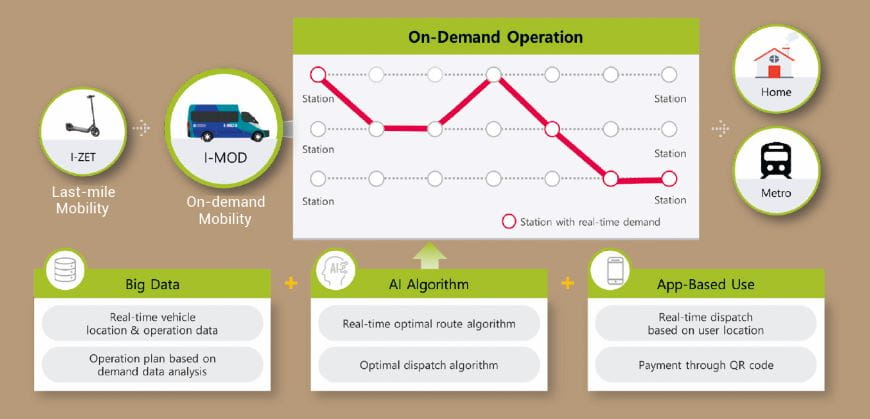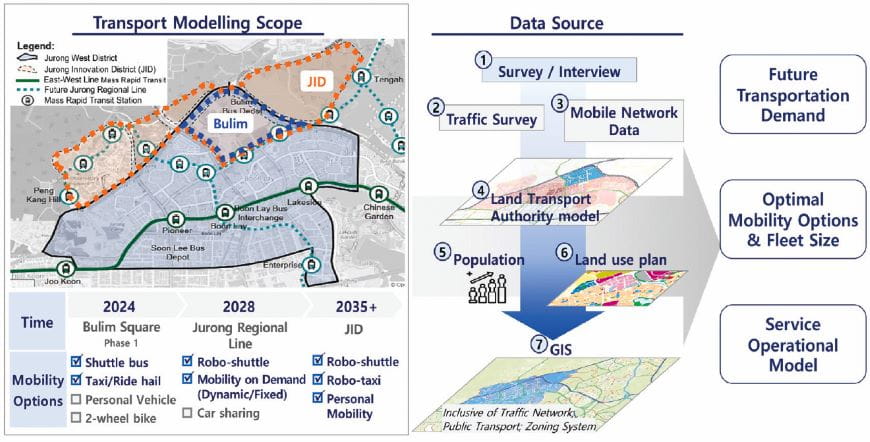

Hyundai operated the EnableLA service in Los Angeles using Palisade and Telluride sport utility vehicles to form a fleet of wheelchair accessible vehicles. Image credit: Hyundai
As one of the leading global automakers, Hyundai is committed to enabling everyone to experience the joy and freedom of travel by making transportation more accessible in two ways: firstly, by providing services that can be utilised by all people; and, secondly, by making these services environmentally and economically sustainable. Thus, it is necessary to address a myriad of complex and challenging factors, such as:
-
The diversity of citizens' needs,
-
The need for different approaches in brownfield and greenfield cities, and
-
The time-consuming and sensitive coordination and planning processes involving diverse stakeholders, including governments, public and private transportation providers, and commuters.
Driven by the intrinsic motivation to understand the supply and demand tensions underpinning mobility choices, the private sector plays a key role in enabling positive commuter choices and supporting public-private partnerships that sustain such choices. Technology, with its ability to connect, analyse and scale, further enables wider outreach that support private sector initiatives. Improving accessibility and sustainability of a city’s transportation furthers equity and inclusion.
Discover how we’re leading the movement with integrated and sustainable estates such as Jurong Innovation District and Punggol Digital District.
"Driven by the intrinsic motivation to understand the supply and demand tensions underpinning mobility choices, the private sector plays a key role in enabling positive commuter choices and supporting public-private partnerships that sustain such choices."
Tailoring Vehicles to Enhance Inclusiveness and Accessibility
Enabling accessibility is key to enhancing social equity and inclusivity and allows those who are differently-abled to gain equal access to education, employment, care, and social opportunities as well as participate in the wider society. Vehicle designs that cater to the transport-disadvantaged, whether on physical, social, or economic fronts, offer the most direct way to improve transportation accessibility. In Los Angeles, California, Hyundai Motor Group launched EnableLA, a universal mobility service to assist people with mobility barriers. Hyundai’s Palisade and Telluride sport utility vehicles were modified to provide wheelchair access, incompliance with the Americans with Disabilities Act. The modified wheelchair accessible vehicles are equipped with UV-free antimicrobial lights for improved sanitation and are operated by driver trained to aid users. This real-world effort helps to inform hardware designs that would serve wheelchair users better.

I-MOD leverages Big Data, AI, and App data to plan flexible on-demand public transit routes that utilise existing bus and metro stops. Image credit: Hyundai
The success of EnableLA resulted in its handover to a local fleet operator, which continues to operate the service today. An upcoming Universal Mobility Project aims to expand its services to include the elderly, pregnant women, children and low-income families, and provide different vehicles, such as purpose-build vehicles with a variety of seating configurations and capacities.
On-Demand Mobility as a Gap Filling Solution in Brownfield Cities
A defining feature of developed brownfield cities is the completed infrastructure that may be expensive and difficult to retrofit. The lower-hanging fruits to improve mobility in brownfield cities may lie in supplementing public transportation with demand-responsive mobility services. Unlike other strategies, such as deploying innovative mobility technologies and re-designing infrastructure which may require high capital require high capital, infrastructure investments and time for innovation maturity, adding on-demand services to fill the gaps of public transportation require a better understanding of commuter behaviour.
The ability to supplement existing public transportation services requires a balance in commuter demand—tricky in low-density and/or rural areas—and service supply. Too long a wait makes private cars more attractive, and high frequency of services may not a sustainable business model.
Big data and artificial intelligence are promising enablers for improving predictions of commuter behaviour patterns and optimising transport routes and service provision, overcoming challenges typically faced by on-demand mobility.
Hyundai Motor Group successfully piloted demand-responsive mobility services in Korea to overcome the limitations of public transportation that residents encounter, such as low frequency of service provision and complex routes that may result in long waiting intervals for public buses.
An example is the I-Mobility On Demand (I-MOD) project in Incheon, a fairly mature and well-developed city. Whilst many may be familiar with the Incheon airport, the gateway to South Korea, there are rural areas within Incheon with small populations and limited public transportation.
I-MOD provides on-demand, flexible routing, based on big data, and thus better connectivity transportation to geographically underserved populations. Wait times are reduced by 82%, and travel times by 41%, compared to traditional public buses.
Transportation Modelling with Better Understanding on Future Estate and Travel Patterns in Greenfield Cities

Greenfield transport planning should consider existing and upcoming land use and infrastructure in the area and its surroundings, to ensure seamless connectivity. Image credit: Hyundai
In greenfield cities, there are more options for improving mobility. Unlike brownfield projects, greenfield developments can accommodate changes at the infrastructure level. Road and traffic systems, as well as locations of charging stations, mobility hubs, and so on, can be adjusted.
Hyundai completed a transportation modelling project in a greenfield area in Singapore, in collaboration with JTC Corporation (JTC),who masterplans, develops and operates leading industrial districts. JTC hoped to improve transport options for tenants and Hyundai aimed to improve transport sustainability by optimising the demand-supply gap.
Data—such as land use plans, population statistics, mobile network data, and citizen surveys and interviews on future mobility acceptance—was utilised to project changes in future transportation demand, and model different mobility service combinations and required fleet strength.
With many developments in the pipeline—such as a new MRT line by 2029, and a sky corridor with a 11 km dedicated lane for autonomous vehicles, bikes and pedestrians by 2034—changes to transport infrastructure and citizens’ travel patterns required dynamic simulations go understand the potential impact of infrastructure changes.
The study can shape urban planning guidelines to optimise transport flows and support smart mobility transport models in next-generation estates. It will also maximise the operational efficiency and sustainability of mobility services.
Conclusion
Public-private partnerships play a crucial role to improve accessibility for all commuters and public transportation usage, and future-proof transportation planning. Public infrastructure needs to serve long-term transportation demand and cater to new mobility services, to support more sustainable mobility innovations.
To this end, Hyundai continues to partner the public sector and leverage new technologies to create smart cities with advanced transportation solutions that enhance daily travel and meet the needs of all.
This article was first published in the Centre for Liveable Cities’ Urban Solutions #23.
 A Singapore Government Agency Website
A Singapore Government Agency Website


